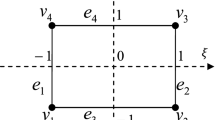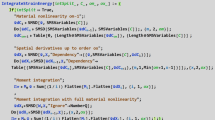Abstract
A High-Performance Reduced-Order Model (HPROM) technique, previously presented by the authors in the context of hierarchical multiscale models for non linear-materials undergoing infinitesimal strains, is generalized to deal with large deformation elasto-plastic problems. The proposed HPROM technique uses a Proper Orthogonal Decomposition procedure to build a reduced basis of the primary kinematical variable of the micro-scale problem, defined in terms of the micro-deformation gradient fluctuations. Then a Galerkin-projection, onto this reduced basis, is utilized to reduce the dimensionality of the micro-force balance equation, the stress homogenization equation and the effective macro-constitutive tangent tensor equation. Finally, a reduced goal-oriented quadrature rule is introduced to compute the non-affine terms of these equations. Main importance in this paper is given to the numerical assessment of the developed HPROM technique. The numerical experiments are performed on a micro-cell simulating a randomly distributed set of elastic inclusions embedded into an elasto-plastic matrix. This micro-structure is representative of a typical ductile metallic alloy. The HPROM technique applied to this type of problem displays high computational speed-ups, increasing with the complexity of the finite element model. From these results, we conclude that the proposed HPROM technique is an effective computational tool for modeling, with very large speed-ups and acceptable accuracy levels with respect to the high-fidelity case, the multiscale behavior of heterogeneous materials subjected to large deformations involving two well-separated scales of length.






















Similar content being viewed by others
Notes
The indicial notation of the compatibility equation is: \((\nabla \wedge \varvec{\zeta })_{ql}= \epsilon _{lip} \frac{\partial \varvec{\zeta }_{pq}}{\partial \varvec{X}_i}\), where \(\epsilon\) is the permutation tensor.
Stationarity is strictly considered only for infinistesimal variations of \(\tilde{\varvec{F}}_{\mu }\).
Here, we introduce an abuse of notation. The expression \({\varvec{\Psi }}_{j}\left( \varvec{Y}\right) \in {\mathbb {R}}^4\) should be interpreted as the one-to-one mapping from the vector \({\varvec{\Psi }}_j\in {\mathbb {R}}^{4N_{pg}}\) to \(N_{pg}\) vectors \({\varvec{\Psi }}_{j}\left( \varvec{Y}\right) \in {\mathbb {R}}^4\) where \(\varvec{Y}\) takes the \(N_{pg}\) discrete values of the Gauss point positions. This mapping is a redistribution of the components of \({\varvec{\Psi }}_j\).
Since Eq. (17) is homogeneous, linear combinations of basis fulfilling strain compatibility give rise to compatible strains.
Speed-up are evaluated as the ratio between time required to compute the HFFEM solution and the time required to compute the reduced model solution.
The acoustic tensor in indicial notation is \(\varvec{Q}_{ik}= \varvec{N}_j {\mathbb {A}}_{ijkl} \varvec{N}_l\).
Abbreviations
- \(n_{F}\) :
-
Number of orthonormal reduced basis for the micro-gradient deformation fluctuation space
- \(n_{\varphi }\) :
-
Number of orthonormal reduced basis for the micro-elastic free energy space
- \(N_{pg}\) :
-
Number of quadrature points of the HFFEM (Gauss point number)
- \(N_{r}\) :
-
Number of quadrature points defining the ROQ rule
- \(N_{snp}\) :
-
Total number of snapshots taken from the micro-cell sampling program
- \({[}\varvec{\chi }{]}_{\tilde{\varvec{F}}_{\mu }}\) :
-
Matrix of snapshots of deformation gradient fluctuations
- \({[}\varvec{\chi }{]}_{\varphi _{\mu }}\) :
-
Matrix of elastic energy snapshots
- \(\{{\varvec{\Psi }}\}\) :
-
Reduced order basis of the deformation gradient fluctuations
- \(\{\varvec{\Phi }\}\) :
-
Reduced order basis of the elastic energy
- POD:
-
Proper Orthogonal Decomposition
- SVD:
-
Singular Value Decomposition
- HPROM:
-
High-Performance Reduced Order Model
- HROM:
-
Hyper-Reduced Order Model.
- HFFEM:
-
High-Fidelity Finite Element Model (model based on the original high-order finite element mesh)
- ROM:
-
Reduced Order Model
- ROQ:
-
Reduced Optimal Quadrature
- IBVP:
-
Initial Boundary Value Problem
- RVE:
-
Representative Volume Element
References
Miehe C, Schotte J, Schröder J (1999) Computational micro–macro transitions and overall moduli in the analysis of polycrystals at large strains. Comput Mater Sci 6:372–382
Terada K, Kikuchi N (2001) A class of general algorithms for multi-scale analyses of heterogeneous media. Comput Methods Appl Mech Eng 190(40):5427–5464
Feyel F, Chaboche J (2000) FE2 multiscale approach for modelling the elastoviscoplastic behaviour of long fibre SiC/Ti composite materials. Comput Methods Appl Mech Eng 183:309–330
Michel J, Moulinec H, Suquet P (1999) Effective properties of composite materials with periodic microstructure: a computational approach. Comput Methods Appl Mech Eng 172(1–4):109–143
Ryckelynck D (2009) Hyper-reduction of mechanical models involving internal variables. Int J Numer Methods Eng 77(1):75–89
Hernández J, Oliver J, Huespe A, Caicedo M, Cante J (2014) High-performance model reduction techniques in computational multiscale homogenization. Comput Methods Appl Mech Eng 276:149–189
Oliver J, Caicedo M, Huespe A, Hernández J, Roubin E (2017) Reduced order modeling strategies for computational multiscale fracture. Comput Methods Appl Mech Eng 313:560–595
Farhat C, Chapman T, Avery P (2015) Structure-preserving, stability, and accuracy properties of the energy-conserving sampling and weighting method for the hyper reduction of nonlinear finite element dynamic models. Int J Numer Methods Eng 102:1077–1110
Carlberg K, Tuminaro R, Boggs P (2015) Preserving lagrangian structure in nonlinear model reduction with application to structural dynamics. SIAM J Sci Comput 37(2):B153–B184
Oliver J, Caicedo M, Roubin E, Huespe A, Hernández J (2015) Continuum approach to computational multiscale modeling of propagating fracture. Comput Methods Appl Mech Eng 294:384–427
Sánchez P, Blanco P, Huespe A, Feijóo R (2013) Failure-oriented multi-scale variational formulation: micro-structures with nucleation and evolution of softening bands. Comput Methods Appl Mech Eng 257:221–247
de Souza Neto E, Feijóo R Variational foundation on multi-scale constitutive models of solids: small and large strain kinematical formulation, LNCC Research & Development Report No 16
Blanco P, Sánchez P, de Souza Neto E, Feijóo R (2016) Variational foundations and generalized unified theory of RVE-based multiscale models. Arch Comput Methods Eng 23(2):191–253
Lubarda V, Benson D (2001) On the partitioning of the rate of deformation gradient in phenomenological plasticity. Int J Solids Struct 38(38):6805–6814
Oliver X, Agelet C (2017) Continuum mechanics for engineers. Theory and problems, UPCommons. http://hdl.handle.net/2117/102979; 10.13140/RG.2.2.25821.20961
Hernandez J, Caicedo M, Ferrer A (2017) Dimensional hyper-reduction of nonlinear finite element models via empirical cubature. Comput Methods Appl Mech Eng 313:687–722
Yaqub A, Rizwan E, Me-140 workshop technology, Air University, Department of Mechanical & Aerospace Engineering
Fernandino D, Cisilino A, Toro S, Sanchez P (2017) Multi-scale analysis of the early damage mechanics of ferritized ductile iron. Int J Fract 207:1–26
Neto E, Pires F, Owen D (2005) F-bar-based linear triangles and tetrahedra for finite strain analysis of nearly incompressible solids. Part I: formulation and benchmarking. Int J Numer Meth Eng 62(3):353–383
Toro S, Sánchez P, Huespe A, Giusti S, Blanco P, Feijóo R (2014) A two-scale failure model for heterogeneous materials: numerical implementation based on the finite element method. Int J Numer Meth Eng 97(5):313–351
Oden J, Belytschko T, Fish J, Hughes T, Johnson C, Keyes D, Laub A, Petzold L, Srolovitz D, Yip S, Revolutionizing engineering science through simulation. National Science Foundation Blue Ribbon Panel Report 65, www.nsf.gov/pubs/reports/sbes_final_report.pdf
Simo JC (1998) Numerical analysis and simulation of plasticity. Handb Numer Anal 6:183–499
Acknowledgements
The authors acknowledge the financial support from the European Research Council through the following grants: 1) European Union Seventh Framework Programme (FP/2007-2013)/ERC Grant Agreement N. 320815 (ERC Advanced Grant Project Advanced tools for computational design of engineering materials COMP-DES-MAT) and 2) Proof of Concept: ERC-2017-PoC 779611 (Computational catalog of multiscale materials: a plugin library for industrial finite elements codes, CATALOG). Also, second and fourth authors acknowledge the financial support from CONICET and ANPCyT (grants PIP 2013-2015 631 and PICT 2014-3372). The authors would like also to acknowledge the support of Dr. Joaquin Hernández, from CIMNE, on the algorithmic and technical aspects of the reduced order integration methods used in this work.
Author information
Authors and Affiliations
Corresponding author
Ethics declarations
Conflict of interest
On behalf of all authors, the corresponding author states that there is no conflict of interest.
Appendix A: Constitutive Model Equations
Appendix A: Constitutive Model Equations
In this appendix, we summarize the constitutive equations for modeling the micro-cell components of the ferritic ductile iron utilized in Sect. 5. The \(J_2\)-plasticity model here adopted is similar to that presented in Sections 50–3 of the book [22].
Such as assumed in Sect. 2.3, we take a multiplicative decomposition of the micro-deformation gradient: \(\varvec{F}_{\mu }= \varvec{F}^e_{\mu } \varvec{F}^p_{\mu }\), where \(\varvec{F}^e_{\mu }\) and \(\varvec{F}^p_{\mu }\) are the elastic and plastic deformation gradients, respectively. We also assume an additive decomposition of the free energy, see Eq. (11). In this context, the elastic free energy part is defined by the Henky model given by
where \(\gamma_\mu\) and Gμ are the Lamè parameters (\(\gamma_\mu =\frac{E_\mu\nu_\mu }{(1+\nu_\mu )(1-2\nu_\mu ))}\), \(G_\mu=\frac{E_\mu}{2(1+\nu_\mu )}\) ), and \((\epsilon _{\mu }^e)_i\) are the logarithmic stretching
being \(\lambda ^e_i\) the stretching satisfying
From Eq. (11), the Kirchhoff stress, \(\varvec{\tau }\), is given by
where the principal stresses \(\tau _i\) (for \(i=I, \textit{II}, \textit{III}\)), are
and \(\varvec{n}_i\) are the eigenvectors of the tensor \(\left( \sqrt{\varvec{F}^e_{\mu }(\varvec{F}^e_{\mu })^T}\right)\). The first Piola-Kirchhoff stress can be computed from \(\varvec{P}_{\mu }= \varvec{\tau }_{\mu } \varvec{F}^{-T}_{\mu }\).
The free energy plastic part is defined by
with the internal variable \(\alpha _{\mu }\) being the cumulative plastic strain which rate is defined by
Considering the Eq. (49), the radius of the von Mises yield function results
Rights and permissions
About this article
Cite this article
Caicedo, M., Mroginski, J.L., Toro, S. et al. High Performance Reduced Order Modeling Techniques Based on Optimal Energy Quadrature: Application to Geometrically Non-linear Multiscale Inelastic Material Modeling. Arch Computat Methods Eng 26, 771–792 (2019). https://doi.org/10.1007/s11831-018-9258-3
Received:
Accepted:
Published:
Issue Date:
DOI: https://doi.org/10.1007/s11831-018-9258-3




